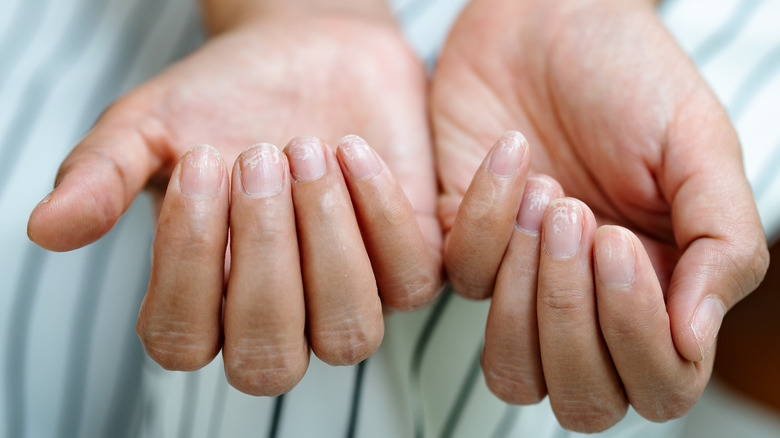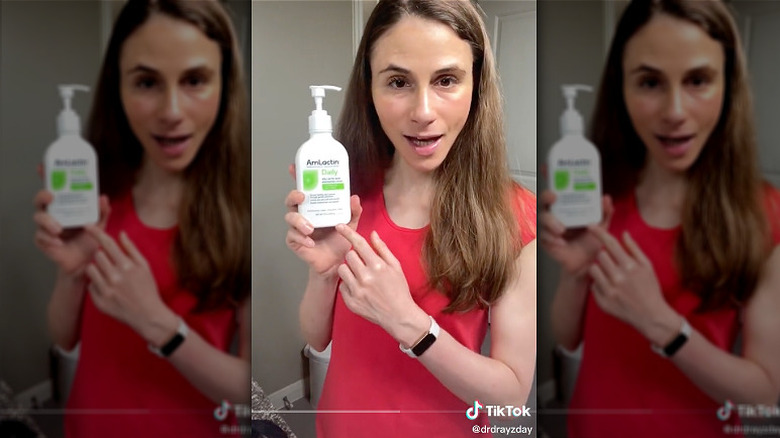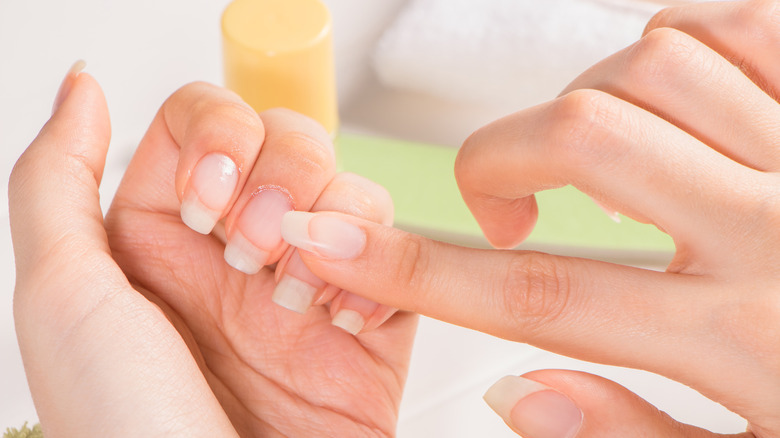We Should All Be Exfoliating Our Nails. Here's Why
We've all heard of skin exfoliation before, but what about nail exfoliation? As it turns out, it's a very real process that anyone can do in the comfort of their own home, and social media influencers are now showing their followers how to do it.
Board-certified dermatologist Dr. Andrea Suarez (who goes by "Dr Dray" on TikTok) posted a video explaining nail exfoliation on the social media app. As of the end of 2022, it had amassed more than 40,000 views from followers — many of whom were likely looking for a way to rehab their natural nails. As Dr. Suarez explained in her video, you only need two key ingredients — a moisturizer and alpha hydroxy acid (glycolic or lactic acid both work). The acid does the exfoliating, while the moisturizer softens the cuticles and your skin at the end of the process. The result? Healthier nails with no unsightly flaking or peeling.
That being said, nail exfoliation isn't just for those who have put their natural nails through the wringer. "Your nails have layers of dead nail cells — aka onychocytes — that become dehydrated and damaged from environmental exposures such as water, temperature changes, as well as chemicals from products, polish remover being the biggest culprit," board-certified dermatologist and nail specialist Dr. Dana Stern explained to Well+Good. By removing this buildup on your nails, you can eliminate everything from discoloration to ridges.
What exactly is nail exfoliation, anyway?
If you understand the concept of exfoliation — the removal of dead skin cells — nail exfoliation isn't much different. In the most basic sense, it involves removing damaged keratin that's sitting on the surface of your nails. As Dermatology Times explains, the process used to be coined "nail filing," but has since become referred to as nail exfoliation.
To do it yourself at home, you can use an alpha hydroxy acid, as some TikTok creators have explained — or you can use nail files. There are files specifically designed for nail exfoliation that have different grits, each with a separate purpose. The coarse grit, for example, is meant to eliminate the dead keratin on the surface of your nails. Alternatively, the fine grit file is often used last to polish your nails and restore their shine.
While nail exfoliation sounds like a fix-all for those with brittle or peeling natural nails, it's important to exercise moderation. "I would recommend regular – but not daily – exfoliation," manicurist Ami Streets told Refinery29. "As with facial exfoliation (depending on your skin type, texture and products used), daily use of exfoliants could be too frequent and can result in irritation, redness or peeling. Choose your exfoliant wisely. You can always work up to using stronger chemical-based exfoliants once you have established your tolerance level."
Why you should try exfoliating your nails
Even if you aren't constantly painting your nails, sporting press-ons, or wearing acrylics, there's a good chance that you could still benefit from nail exfoliation. When you remove dead cells from your nails, you can reduce the chances of developing ridges and discoloration while removing keratin granulations — those white patches that can develop from wearing nail polish for long periods of time. Additionally, you'll be maintaining the health of your nail plates, which are essential to the structure of your nails.
If you choose to use an alpha hydroxy acid to exfoliate, like lactic acid, massage it into your nails in a circular motion with a cotton pad or cotton ball. Afterward, rinse your nails and cuticles, and begin the hydration process with the moisturizer of your choice. How often you exfoliate your nails will depend on how well they tolerate the product you use to remove the dead nail cells. Other factors, such as how frequently you wear gel polish or acrylics, will also play a role in your nail care routine.
As Healthline explains, your nails can be indicative of your overall health. Ideally, they should be smooth and have consistent coloring. While they may become brittle with age, any unusual abnormalities are always worth mentioning to your doctor. They can provide insight into what your nails might be telling you about your well-being, in addition to information on how to keep them healthy over time.


